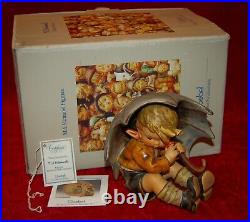
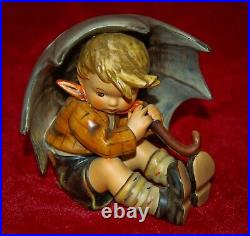
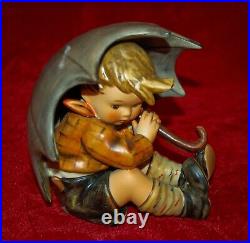
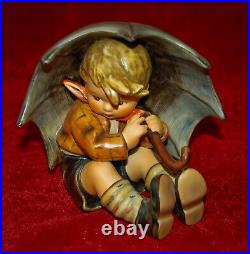
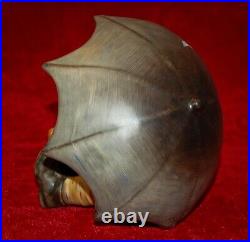
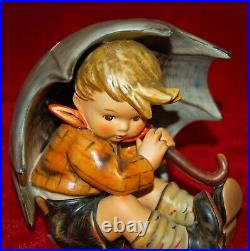
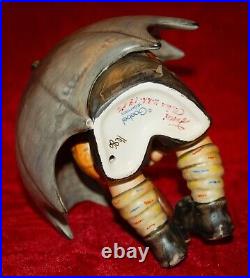
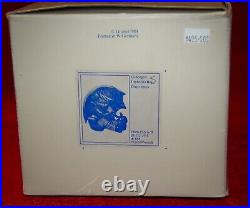
Made in Rodental, Germany. SOUTH FLORIDA ESTATE SALE. Please, check out other collectibles and antiques we have available for sale. We are offering 1000+ items collection. This Hummel figurine is in excellent condition. It comes with original box and certificate of authenticity! Only within the continental U. The residents of HI/AK/U. Since 1935, the charming but simple M. Hummel figurines of boys and girls have easily captured hearts. In them we see, perhaps, our son or daughter, sister or brother, or even ourselves when we were racing along the paths of happy childhood. When you see such figurines as the School Boy or School Girl, you may be taken back to your own school days. Seeing the figurine Culprits could bring back the time when you purloined your first apple from a neighbor’s tree and were promptly chased away by their dog. Perhaps you delight in the beauty of the Flower Madonna or Shepherd’s Boy, with there little round faces and big questioning eyes. Through good times and through bad, Hummel figurines have been cherished members of many collections, or handed down to a loved one as a keepsake. You may ask yourself what artist is behind these beguiling figurines. Who is the person with the talent to portray beauty and innocence with such simplicity? The answer is Berta Hummel, a Franciscan sister called Maria Innocentia. Berta Hummel was born on May 21, 1909, in Massing in lower Bavaria, which was located about 40 miles northeast of Munich, Germany. In a family of two brothers and three sisters in a home where music and art were part of everyday life. In this environment, her talent for art was encouraged and nourished by her parents. Berta attended primary school between 1915 and 1921. During these early years, she demonstrated the great imagination so necessary for an artist. She created delightful little cards and printed verses for family celebrations, birthdays, anniversaries, and Christmas. Her subjects were almost always the simple objects with which she was familiar: flowers, birds, animals, and her friends. In her simple child’s world, she saw only the beautiful things around her. When she finished primary school, Berta was enrolled in the Girls Finishing School in Simbach in 1921, in order to nurture and train her talent further and to give her a wider scope of education and experience. Here again, her artistic talent was recognized and upon finishing, it was decided that she should go to a place where she could further cultivate that talent and realize her desire to pursue art as a vocation. In 1927, Berta moved to Munich, where she entered the Academy of Fine and Applied Arts. There she lived the life of an artist, made friends, and painted to her heart’s content. At the academy, she acquired full mastery of art history, theory, and technique. It was here also that she met two Franciscan sisters who, like herself, attended the academy. There is an old adage that art and religion go together. Berta Hummel’s life was no exception. She became friends with the two sisters and began to think that this might be the best way to serve. Over time, she decided to join the sisters in their pilgrimage for art and God, in spite of the fact that she had been offered a position at the academy. For a time, Hummel divided her days between her talent for art and her love for humanity and hours of devotion and worship. She then made a decision that surprised some: She entered the Convent of Siessen in 1931, a teaching order in Saulgau that emphasized the arts. Berta had a strict Catholic background, and searching for a higher meaning had always been important to her. In 1934, Berta Hummel took her vows in the Convent of Siessen on August 30, 1934, becoming Sister Maria Innocentia Hummel. Although Berta Hummel (now Sister Maria Innocentia) gave her life over to an idea she thought greater than any worldly aspiration, the world became the recipient of her wonderful works. Within the walls and the beautiful surroundings of the centuries-old convent, she created the paintings and drawings that were to make her famous. Within these sacred confines, her artistic desires enjoyed unbounded impetus. As she adjusted to convent life, Maria Innocentia found fulfillment in teaching art to kindergarteners and leading the convent’s Vestments Department, designing clerical robes, church altar cloths and banners. She also began to sketch the endearing pictures of children that would someday make her famous. These were stylized images of country children going to school, making music, playing simple games. The colors were muted, the style loose and sketchy. And the children were enchanting. Cheeks were plump, hair windswept. Shoes were too big, and socks sagged. The artwork was published in a variety of forms, including postcards, and Sister Maria Innocentia Hummel began to develop a reputation as a fresh talent in the world of religious art. Little did her superiors dream that this modest blue-eyed artist who had joined their community would someday win worldwide renown. Much less did they realize what financial assistance Maria Innocentia’s beloved convent would derive from her work as an artist. During World War II, in 1945, after the French had occupied the region, the noble-minded artist’s state of health was broken. Sadly, Sister Maria Innocentia Hummel suffered from tuberculosis and died in 1946 at the age of only 37. An Artistic Board at the Convent of Siessen was appointed to carry on her legacy. Hummel figurines, modeled according to Sister Maria Innocentia’s work, are known all over the world. They are her messengers, bringing pleasure to many, many people. In an area very near Coburg in northern Bavaria, Franz Detleff Goebel and his son, William Goebel, founded the company in 1871. Once known as Oeslau, the village is now known as Rödental. Initially, the company manufactured slates, pencils, and marbles, and after 1879, it was well into the production of porcelain dinnerware and beer steins. By the mid-1910s, a third generation, Max Louis Goebel, had taken the helm of the company and it began manufacturing fine earthenware products. His son, Franz Goebel, became active in the company, and the two of them developed a line of porcelain figurines that was well accepted on the international market. Upon Max Louis’ death in 1929, Franz took over the running of the company along with his brother-in-law Dr. Eugen Stocke, a trained economist, who was the financial manager of the operation. Sister Maria Innocentia’s art came to the attention of Franz in December 1933 in the form of religious note cards for the Christmas and New Year seasons. These cards were brand-new publications of her art by Ars Sacra Josef Muller Verlag. This company has since evolved into ArsEdition, well known to collectors of prints and postcards of Hummel art. Remarkably, it was in March of the same year that the Siessen Convent had made an unsolicited inquiry of the Josef Muller firm regarding the possibility of reproducing their Sister Maria Innocentia’s art. Once Franz Goebel saw the cards in Munich, he conceived the idea of translating them into three-dimensional figurines. He sought and gained permission from the convent and Sister Maria Innocentia Hummel. The letter granting Goebel permission stated plainly that all proposed designs must be preapproved before the product could be manufactured. This is true to this day: The convent still has the final say as to whether a proposed design stays within the high standards insisted upon by M. After Franz Goebel gained permission for the company to produce the figurines, it took about a year to model the first examples, make the first molds, experiment with media, and make the first models of fine earthenware. The company presented the first figurines, Hum numbers 1 through 10 with the exception of Hum number 8, at the Leipzig Fair in 1935. They were a great success, and by the end of 1935, there were 46 models in the new line of Hummel figurines. Production of Hummel figurines dwindled during the years of World War II, and toward the end of the war, production ceased completely. During the American Occupation, the United States Military Occupation Government allowed Goebel to resume operation. This included the production of Hummel figurines. During this period, the figurines became quite popular among U. Servicemen in the occupation forces, and upon their return to the United States, many brought them home as gifts. This activity engendered a new popularity for Hummel figurines. By the early 1930s, Goebel had gained considerable experience and expertise in fashioning products of porcelain and fine earthenware. If you have a problem with your item please refrain from leaving negative or neutral feedback until you have made contact and given a fair chance to rectify the situation. As always, every effort is made to ensure that your shopping experience meets or exceeds your expectations. This item is in the category “Collectibles\Decorative Collectibles\Sculptures & Figurines”. The seller is “timelessthing” and is located in this country: US. This item can be shipped to United States, New Zealand, Fiji, Papua New Guinea, Wallis and Futuna, Gambia, Malaysia, Taiwan, Poland, Oman, Suriname, United Arab Emirates, Kenya, Argentina, Guinea-Bissau, Armenia, Uzbekistan, Bhutan, Senegal, Togo, Ireland, Qatar, Burundi, Netherlands, Slovakia, Slovenia, Equatorial Guinea, Thailand, Aruba, Sweden, Iceland, Macedonia, Belgium, Israel, Kuwait, Liechtenstein, Benin, Algeria, Antigua and Barbuda, Swaziland, Italy, Tanzania, Pakistan, Burkina Faso, Panama, Singapore, Kyrgyzstan, Switzerland, Djibouti, Chile, China, Mali, Botswana, Republic of Croatia, Cambodia, Indonesia, Portugal, Tajikistan, Vietnam, Malta, Cayman Islands, Paraguay, Saint Helena, Cyprus, Seychelles, Rwanda, Bangladesh, Australia, Austria, Sri Lanka, Gabon Republic, Zimbabwe, Bulgaria, Czech Republic, Norway, Côte d’Ivoire (Ivory Coast), Kiribati, Turkmenistan, Grenada, Greece, Haiti, Greenland, Yemen, Afghanistan, Montenegro, Mongolia, Nepal, Bahamas, Bahrain, United Kingdom, Bosnia and Herzegovina, Hungary, Angola, Western Samoa, France, Mozambique, Namibia, Peru, Denmark, Guatemala, Solomon Islands, Vatican City State, Sierra Leone, Nauru, Anguilla, El Salvador, Dominican Republic, Cameroon, Guyana, Azerbaijan Republic, Macau, Georgia, Tonga, San Marino, Eritrea, Saint Kitts-Nevis, Morocco, Saint Vincent and the Grenadines, Mauritania, Belize, Philippines, Democratic Republic of the Congo, Republic of the Congo, Colombia, Spain, Estonia, Bermuda, Montserrat, Zambia, South Korea, Vanuatu, Ecuador, Albania, Ethiopia, Monaco, Niger, Laos, Ghana, Cape Verde Islands, Moldova, Madagascar, Saint Pierre and Miquelon, Lebanon, Liberia, Bolivia, Maldives, Gibraltar, Hong Kong, Central African Republic, Lesotho, Nigeria, Mauritius, Saint Lucia, Jordan, Guinea, Canada, Turks and Caicos Islands, Chad, Andorra, Romania, Costa Rica, India, Mexico, Serbia, Kazakhstan, Saudi Arabia, Japan, Lithuania, Trinidad and Tobago, Malawi, Nicaragua, Finland, Tunisia, Uganda, Luxembourg, Brazil, Turkey, Germany, Egypt, Latvia, Jamaica, South Africa, Brunei Darussalam, Honduras.
- Brand: Hummel
- Type: Figurine
- Packaging: Box
- Original/Reproduction: Original
- Style: 1980s
- Features: Boxed
- Material: Porcelain
- Time Period Manufactured: 1980-1989
- Country/Region of Manufacture: Germany